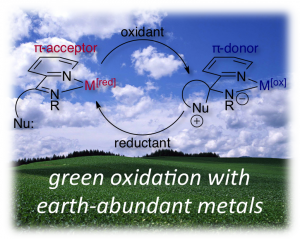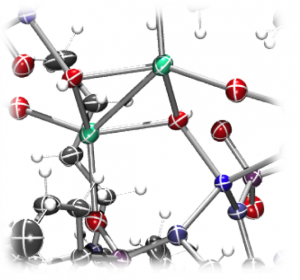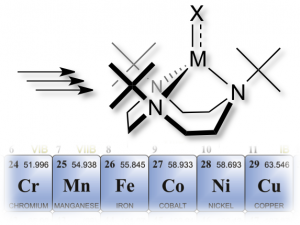Research in the Scarborough Lab is designed to promote the discovery and development of new homogeneous catalysts derived from the earth-abundant first-row transition metals. We employ a variety of techniques in our pursuits, but the core of our research is organic and inorganic synthesis. These studies are enabled, informed, and inspired by spectroscopic studies, electrochemical experiments, X-ray crystallography, and electronic structure analysis and computations. In particular, we are targeting new catalysts for redox transformations of organic substrates, in particular by group-transfer reactivity. Group-transfer reactions proceed through intermediates with metal-ligand multiple bonding, and we are informing our catalyst development studies with fundamental investigations into the nature of metal-ligand multiple bonding involving mid-to-late first-row transition metals. Three ongoing research projects are described below.
Developing group-transfer catalysts from earth-abundant metals
Inspired by the biological machinery for metal-catalyzed group-transfer reactions (e.g. Cytochrome P450 enzyme superfamily, the oxygen-evolving complex of Photosystem II, and FeMoCo of nitrogenase enzymes), which have precisely tuned electronic structures and steric profiles, as well as related active sites in heterogeneous catalysis, we are developing highly tunable ligand scaffolds that provide fine control of electronic structure, first and second coordination spheres, and active-site properties. By tuning these variables, we seek to develop new catalysts for group transfer reactions that employ environmentally benign reagents, particularly molecular oxygen. Studies on this project employ organic and inorganic synthesis, X-ray crystallography, electrochemistry, routine electronic-structure analysis, modern computational methods, and state-of-the-art spectroscopic tools.
Highly electrophilic metal–ligand multiply bonded complexes for oxidation catalysis
We are coupling high metal-ligand bond orders achievable in three-fold symmetry with fine control of the metal coordination spheres to access electrophilic oxidants for catalytic aerobic substrate oxidation. The design of the supporting ligand is critical – these ligands must enforce the appropriate symmetry, maintain a low coordination number, and be highly oxidatively stable. We are exploring the catalytic oxidation capacity of such electrophilic compounds in the development of novel organic transformations. The tools employed in this research are exploratory synthesis, spectroscopy, electrochemistry, X-ray crystallography, and reaction optimization, and the efforts are informed by electronic structure analysis and modern theory.
 Electronically responsive ligands for redox catalysis with earth-abundant metals
Electronically responsive ligands for redox catalysis with earth-abundant metals
The two-electron paradigm that dominates chemists’ understanding of the reactivity of organic compounds (nucleophile/electrophile reactivity) is not often shared by earth-abundant transition metals. Some of the most successful transition-metal catalysts react via classical two-electron processes (e.g. oxidative addition, reductive elimination, and insertion), and these metals, typically Ru, Os, Pd, Pt, Rh, Ir, and Au, are among the rarest naturally occurring elements in the earth’s upper crust. Controlling the reactivity of earth-abundant first-row transition metals to proceed via analogous two-electron processes is an unsolved problem, and its realization will have a major impact on chemical industries. We are pursuing an approach that harnesses the native two-electron reactivity of organic functional groups to enforce two-electron reactivity at a first-row metal center through ligand design. The goal of this research is the development of earth-abundant catalysts for aerobic oxidative transformations of organic substrates. Research in this project is based on organic synthesis, and is complemented by coordination chemistry, spectroscopy, electrochemistry, and X-ray crystallography.


